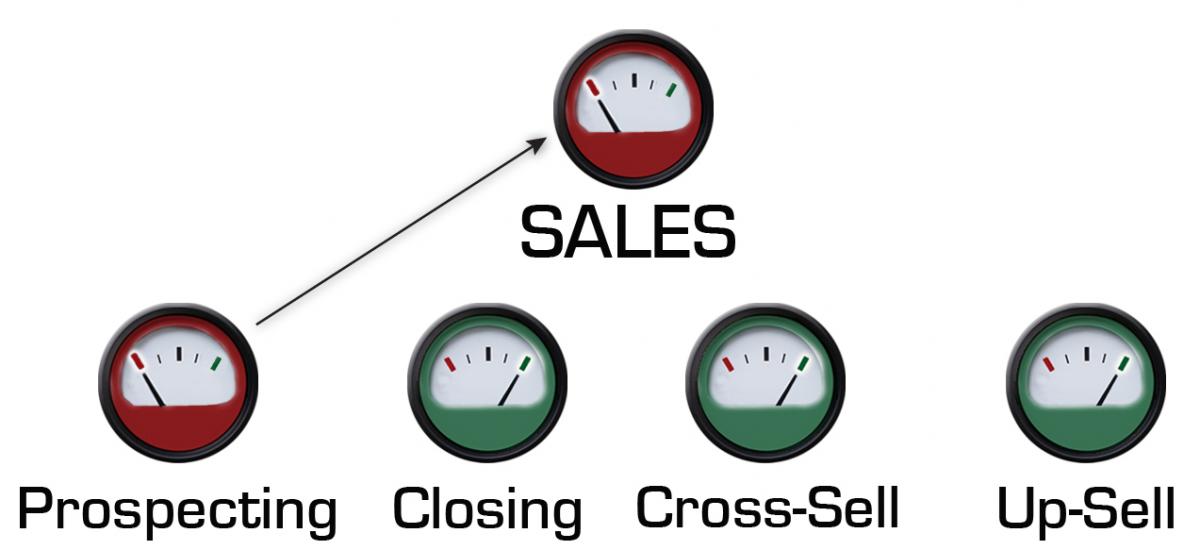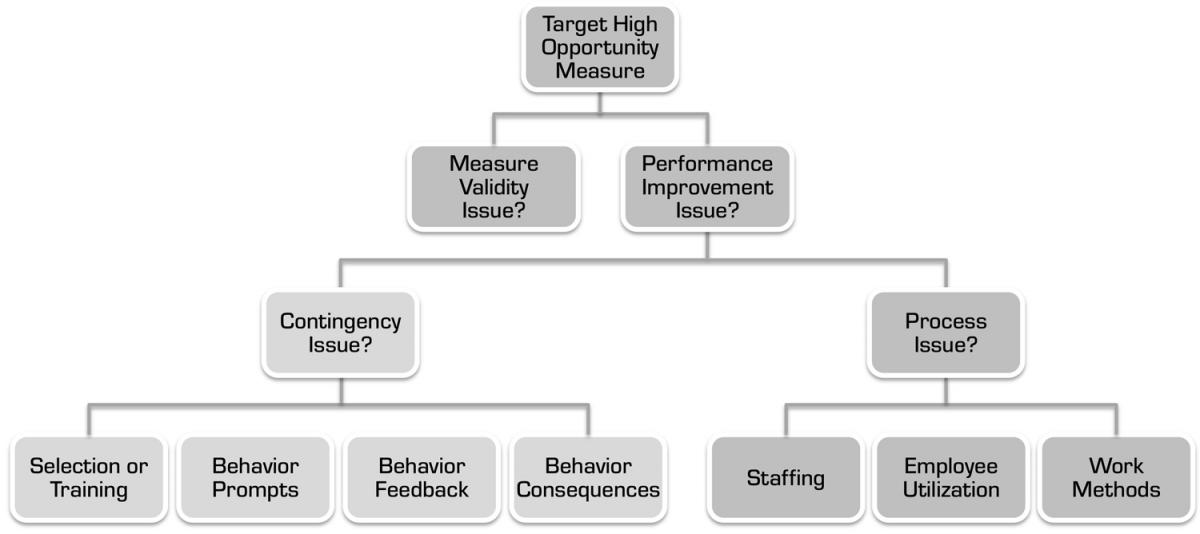Business, Blind Men, and Elephants: The Need for an Integrated Performance Measurement System
The tale of the five blind men’s first encounter with an elephant depicts how each man describes an elephant based upon which part of the elephant's anatomy he happen to touch. A similar problem occurs in organizational measurement. How each person within an organization describes the 'elephant' is substantially different. The accountant characterizes it as a specified set of financial measures. The Human Resource manager describes the organization as a collection of individuals, each with unique pay and career histories. Executives focus on strategic measures and measures within each of their areas of responsibility. The industrial engineer may describe the organization through standard times and process measures. The Marketing department reviews demographic and industry trend data. The middle manager concentrates on the budget and other departmental indicators. Quality assurance looks at its measures. Employees will be concerned about standards and performance reviews. What measure, then, describes the organization? How can each blind man view the elephant as an integrated whole?
An organization is a group of people working toward common goals. But what is the common goal given this array of disconnected measures? The conventional measurement system may create unrelated or even competing goals. This fails to foster synergy across areas and levels of the organization, and essentially describes the elephant piece by piece. What is needed, then, is an integrated measurement system available to all. A system that communicates goals, directs performances, and provides feedback on how well goals are being accomplished.
Remedial vs. Preventative Performance Measures
For a physician to ensure the effectiveness of a patient's biological system, she must understand the four higher system levels and how they interrelate. At the system level, we say a patient is sick or doesn't feel well. This will trigger an analysis of the lower levels, a diagnosis, and finally the treatment. However, the person may also come to the doctor's office for a 'check-up'. In this case, the patient may not feel sick and is presently functioning well. An examination of the sub-systems, and their interrelations, may find problems that have not yet surfaced at the patient level. This is 'preventive' medicine. In recent years, it has been highly promoted as a more effective healthcare model than the traditional reactive model driven by patient complaints. Preventive care has been shown to be more effective because the problem is often in its early stages and more amenable to intervention. This is also true of organizational performance.
Medical science has developed sophisticated measurement systems. However, organizations are typically antiquated in this respect. Financial reports may, with respect to current profitability, tell us the organization is 'sick' or 'isn't feeling well'. However, they fail to provide a comprehensive view or diagnostic information that can be used to either prevent problems, or pinpoint the causes of the organization's 'illness'.
Five levels of organizational measurement provide a comprehensive account of an organization. These are:
1. Marketplace Performances
2. Functional Area Performances
3. Interdepartmental Performances
4. Job Results
5. Behaviors that Drive Job Results
Level I:
Defining Marketplace Performances
Many executive groups develop sophisticated strategic plans that define the relationship between their organization, the marketplace, and the society at large. Unfortunately, the strategic plan is often not translated to objective measures that can be used to assess whether the plan is being accomplished. Kaplan and Norton recommended in their book, The Balanced Scorecard, that organizations develop a 'balanced scorecard' that could be used to assess the progress of the organization in achieving its strategy. Essentially, the balanced scorecard is designed to include measures of all aspects of the strategy (short-term, long-term, financial, non-financial) in one report. Just as the patients' discomfort provides feedback that sub-systems are not operating optimally, so can a scorecard provide similar feedback for the organization.
After experimenting with many reporting formats, the author chose the Felix and Riggs' 'Performance Matrix'. The matrix priority weights each measure, converts the measures to a common scale, and sums the results to produce a mathematically balanced 'performance index'. The performance index then serves to describe the overall 'health' of the organization with respect to its strategy.
Level II:
Functional Area Performances
Each functional area (division, department, and job) is reviewed to identify the key results the area produces that drive the strategic scorecard results. Some functional areas may have an insignificant impact on a specific strategic measure, and therefore no area measure would be assigned. For example, Finance may have little impact on revenue or Human Resources on working capital efficiency. Often, however, a thorough analysis will find there is, in some cases, an important corresponding result.
7 CRITICAL DRIVERS OF ORGANIZATIONAL SUCCESS

Kaplan and Norton described a measurement system design strategy they termed "The Method of Cascading Objectives". The process consisted of first defining the organizational scorecard, continuing on to the divisions, the departments within the divisions, and finally the job positions within the department. (The number of levels will vary with the organization's size and complexity. For simplicity, only divisions, departments and job positions will be referred to here.) This 'cascading' process ensures proper alignment among organizational levels and has proved to be more efficient than other approaches.
By aligning measures at these two levels, we can begin to 'diagnose' the patient's problem. For example, if working capital efficiency begins to decline, we can examine the division scorecard measures to pinpoint the primary source of the problem. Once the division is identified, we can then look deeper into the organization at the departments, areas, and ultimately job positions.
Level III:
Interdepartmental Performances
Once a specific department, area, or job is identified, we then must determine whether the problem is internal or external. Is the target area's performance deficiency due to internal factors within the department or external inputs from other areas, vendors, or customers? To accurately assess the source of the problem, a third level of measurement is useful. Such measures monitor the workflow across the organization rather than the vertical connections between organizational results and component area results. For example, accounts receivables may be below goal because sales people do not turn in their orders in a timely manner. The problem is, then, in the Sales division rather than Finance.
The development and implementation of corrective actions for interdepartmental performances requires the cooperative effort of two or more areas of the organization. These are sometimes referred to as 'cross-functional teams'. One quick solution to problems across departments is to add a 'linked' measure to the upstream area's matrix. In our example, the upstream area is making it difficult for the downstream area to meet its deadlines due to delays in input. Adding the downstream (receiving) area's 'percent past due accounts' measure to the upstream (sending) area's matrix, holds the upstream unit accountable for the overall timeliness of the work flow. This also holds true for product and service quality, productivity, and other performance dimensions.
Level IV:
Job Results
The seven categories of results measures described above often do not provide sufficient information to assess and improve the performance on the measure. For example, in the medical diagnose metaphor, it is not enough to know the patient has a heart problem - we must pinpoint where in the heart the problem resides. The illustrations below depict the key drivers of two measurement categories - sales and productivity.
SALES DRIVERS

The components of sales are prospecting, closing, cross selling and up selling. These components mathematically relate to sales revenue using the formula:
Sales revenue = # prospects X close % x # products or services sold x avg. product price
For example, if we see 100 prospects in a month and close 20% of them we will produce 20 customers. If each new customer is sold an average 1.5 products, and the average product price is $500, then each customer yields an average $750 in revenue x 20 customers equals total revenue for the month of $15,000.
To increase sales, we would examine each component to determine the one in which an improvement would generate the greatest revenue gain. This can be accomplished by comparing each sales person to the best performer 'exemplar' in each component.
Level V:
Behaviors that Drive Job Results
Ultimately, the first four measurement levels only serve to diagnose and pinpoint improvement opportunities. This process is of little consequence if it does not lead to an actual change in employee behavior. The fact is, if no one does anything different, why should we expect a change in measure performance at any level? Broadly, behavior is a function of two classes of variables - job contingencies and job processes. The following flow chart depicts seven behavior improvement procedures.
The high-level measurements described herein are used to target high opportunity performance measures. Through a 'drill down' analysis we arrive at a specific behavior that drives results on the upper measurement levels. The first decision in the process of improving the behavior is to ensure the associated measure is valid. A review of the measure formula and the data making up the measure is conducted. If the measure is not valid, a behavior change procedure most likely should not be implemented.

If the measure is valid, the next decision is to determine whether the behavior deficiency is due to job contingencies or job processes. Job contingencies refer to factors in the workplace that directly affect the employee's ability or desire to perform. These factors include employee selection and training, behavior 'prompts' or cues, behavior feedback, and behavior consequences. The selection process may place employees in a job who lack the necessary requisite aptitudes to perform successfully. Alternatively, the employees may have the necessary aptitudes but the training is inadequate.
If the employees are capable of performing at goal, and yet performance is unsatisfactory, then the obstacle may be in the organization's performance management system. There are three primary factors to consider if this is the case - prompting, feedback, and consequences. Prompting refers to methods used to communicate in advance the who, what, when, where, and how of employee job tasks. Examples include supervisor direction, instructions, guides, signs, and so on. Missing, uninformative, or infrequent prompts can lead to employee misunderstandings about who should complete a task, what the task is, when the task is to be completed, where tasks are to performed, or how the task should be completed with respect to proper tools and procedures.
Feedback refers to information provided to employees after a task is completed. Feedback may describe the timeliness of the task result, the accuracy, or the cost of completing the result with respect to time and materials. To be effective, feedback needs to be immediate and specific. All too often, organizations fall short on this critical aspect of performance management.
 Consequences result when the employee completes, or fails to complete, an assigned task. A task will only be performed consistently when there are positive consequences (positive reinforcement) for its completion, or when negative consequences can be avoided (negative reinforcement) by its completion. In the absence of consequences, employee performance will be inconsistent or absent. Worse, some organizations unintentional punish desired behaviors, which can substantially reduce the likelihood of these behaviors occurring consistently. For example, an employee volunteers to take on new tasks and initially commits errors. If the employee is only punished for the errors, the chances that they will take on other new assignments is greatly diminished. Another common situation is when a volunteer who is effective is given additional work assignments without any positive consequences.
Consequences result when the employee completes, or fails to complete, an assigned task. A task will only be performed consistently when there are positive consequences (positive reinforcement) for its completion, or when negative consequences can be avoided (negative reinforcement) by its completion. In the absence of consequences, employee performance will be inconsistent or absent. Worse, some organizations unintentional punish desired behaviors, which can substantially reduce the likelihood of these behaviors occurring consistently. For example, an employee volunteers to take on new tasks and initially commits errors. If the employee is only punished for the errors, the chances that they will take on other new assignments is greatly diminished. Another common situation is when a volunteer who is effective is given additional work assignments without any positive consequences.
On the process side of the diagram, the three primary improvement strategies are staffing, utilization and work methods improvements. Productivity may be low, or deadlines missed, due to imprecise staffing. Even with the correct staffing level, work volumes may be distributed among employees such that some have too much to do and others too little. Proper work distribution ensures employees are optimally utilized during the workday. Finally, the work methods may, in themselves, be inefficient. Excess redundancy, wait times, work flow obstacles, and so on will prevent even the best motivated employees from achieving optimal performance levels.
In conclusion, organizations typically lack comprehensive, integrated performance measurement systems. The results are a failure to align employee efforts with the strategy, poor communications, and an inability to pinpoint the specific sources of declining revenue, productivity, and service. The five level measurement system described will optimize employee and organizational performance by solving these issues. Management will then be able to describe and care for its 'elephant'.


